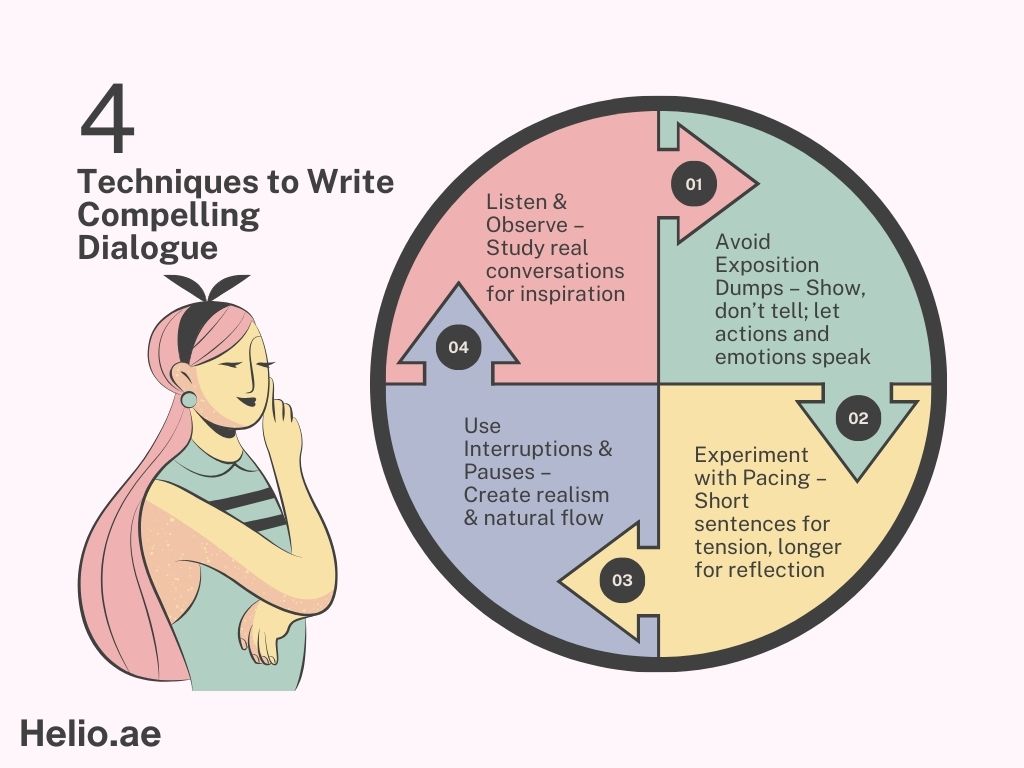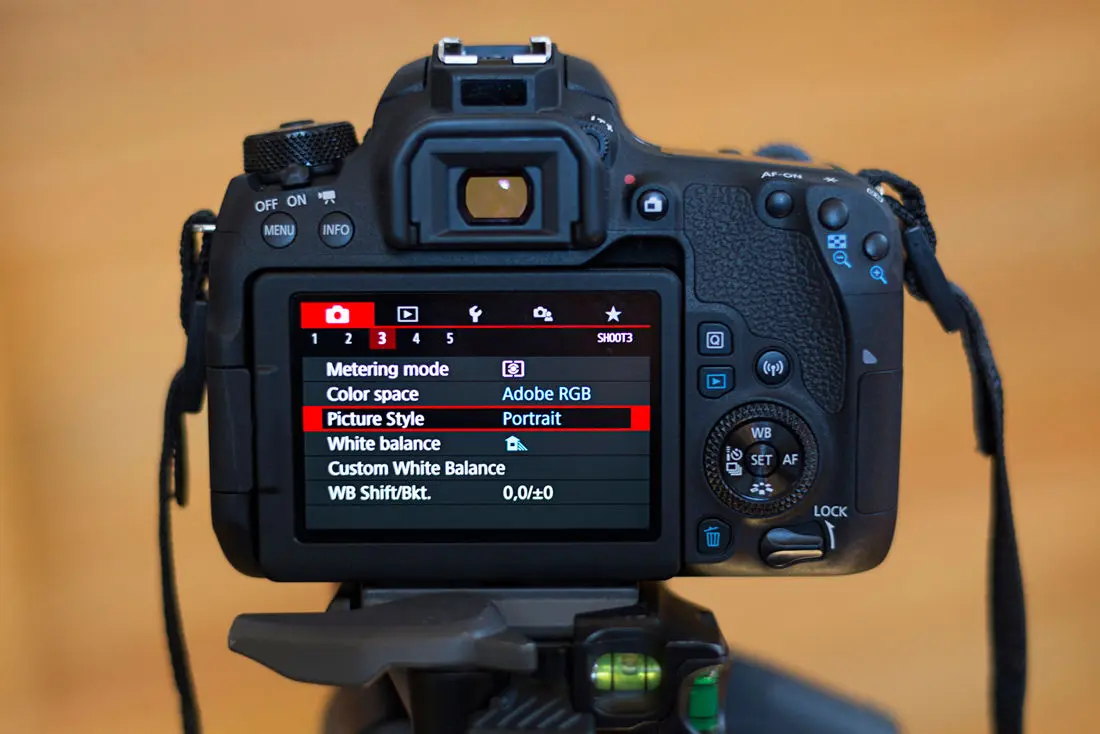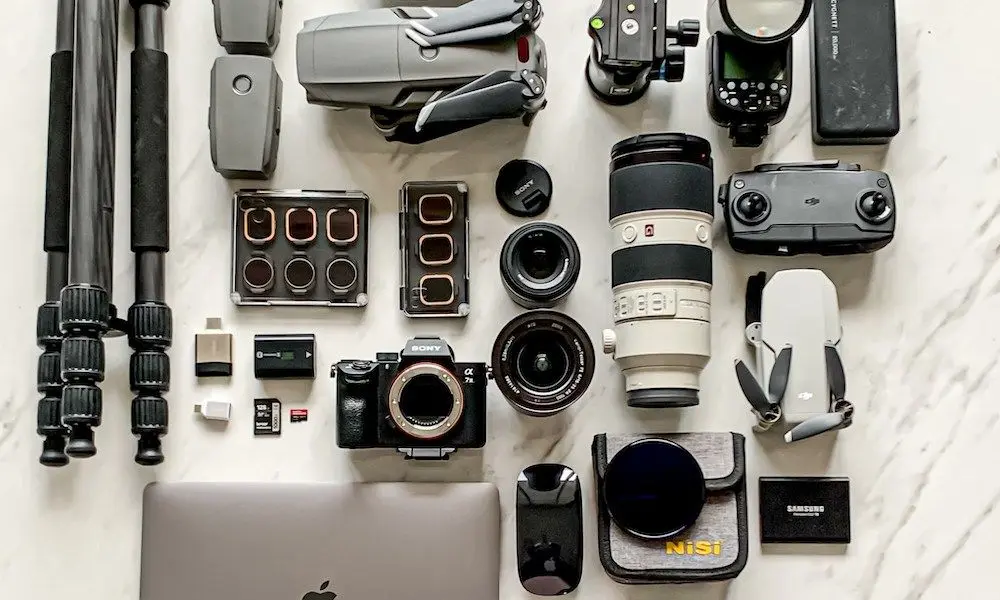Listen to this blog post:
Dialogue is the heart of any film script. It’s where characters come alive, conflicts unfold, and stories captivate audiences. For aspiring filmmakers and scriptwriters in the UAE, mastering the art of crafting compelling dialogue for film is essential. If you are looking for a trusted source, this comprehensive guide will equip you with the knowledge and techniques to create dialogue that resonates with your audience and elevates your screenplay to new heights. Be with Helio agency and get a good grasp of film scripts.
How to Write Dialogue in a Screenplay
Developing effective dialogue in a screenplay is a strategic process that requires understanding character dynamics, plot objectives, and pacing. In this section, we will explore strategic approaches to crafting dialogue that intensifies scenes and draws the audience deeply into your narrative world.
1. Concept and Narrative: Discover Your Inspiration
Finding inspiration for your screenplay begins with observing the world around you. Everyday life is filled with moments, conversations, and emotions that can spark ideas for your story. Take note of intriguing dialogues you hear in public places or interactions that leave a lasting impression. These observations can form the foundation of authentic dialogue in your script.
A crucial part of this process is understanding creative concept development in video production, which involves crafting a cohesive vision that brings your ideas to life. This step ensures your story’s dialogue aligns seamlessly with the overall narrative and visual aesthetic, enhancing the emotional resonance of your screenplay.
Another source of inspiration is literature. Reading books across various genres can introduce you to different writing styles and character dynamics. Analyze how authors convey emotions and subtext through dialogue, and incorporate these techniques into your work.
Remember personal experiences. Reflect on pivotal moments in your life and the conversations that shaped them. These real-life interactions can be powerful tools for crafting genuine and relatable dialogue.
| Step | Description | Action |
|---|---|---|
| Concept and Narrative | Find inspiration by observing the world around you and analyzing books, life experiences, and conversations. | Incorporate your observations and personal experiences to create authentic dialogue that aligns with the story’s theme. |
| Characters | Develop distinct personalities for each character, including background, goals, and motivations. | Create unique speech patterns and vocabulary for each character to make their dialogue believable and engaging. |
| Dialogue | Make your characters come alive by writing natural dialogue that reflects real-life conversations, including subtext and interruptions. | Pay attention to pauses, subtext, and how characters express their emotions through dialogue. |
| Conflict | Use dialogue to reveal conflict between characters, which can be internal or external. | Introduce tension and opposing viewpoints through dialogue to keep the plot moving forward. |
| Format | Ensure your screenplay follows industry-standard formatting for readability and professional presentation. | Use proper margins, Courier font, and scene headings to format your script according to industry norms. |
2. Characters: Develop Distinct Personalities
Creating distinct characters is crucial for engaging dialogue. Start by building comprehensive character profiles. Consider their backgrounds, motivations, and goals. A character’s experiences and personality traits should influence speaking and interacting with others.
Understanding a character’s arc is essential for writing dialogue that reflects their growth. How do their goals evolve throughout the story? How do their relationships change? Use dialogue to highlight these transformations, adding depth and complexity to your characters.
To bring your characters’ personalities to life, give each one a unique voice. Consider their speech patterns, vocabulary, and tone. A well-developed character will have a voice that is unmistakably their own, enhancing the authenticity of your dialogue.
3. Dialogue: Make Your Characters Alive
Writing authentic dialogue requires a keen ear for natural speech. Listen to conversations around you and pay attention to how people communicate. Real conversations are often filled with subtext, pauses, and interruptions. Incorporate these elements into your dialogue to make it feel more realistic.
Subtext is a powerful tool for adding depth to your dialogue. Characters may say one thing but mean another, revealing hidden emotions or intentions. Use subtext to create tension and intrigue, drawing your audience deeper into the story.
Consider the setting and period when crafting dialogue. Language evolves, and cultural nuances can significantly impact how characters speak. Ensure your dialogue is consistent with the world you’ve created, enhancing the believability of your script.

4. Conflict: Crafting an Engaging Plotline
Conflict is the driving force of any screenplay, and dialogue is a key element in its development. Introduce conflict through conversations that reveal opposing desires or viewpoints. This tension can create compelling dynamics between characters.
There are various types of conflict to explore in your dialogue. Internal conflict occurs within a character, while external conflict involves opposing forces. Dialogue can effectively convey both, providing insight into a character’s struggles and motivations.
Build conflict gradually to maintain audience engagement. Allow characters to challenge each other, sparking debates and disagreements. This tension keeps the plot moving forward and invites viewers to invest emotionally in the outcome.
5. Format: Understanding Screenwriting Structure
A well-structured screenplay adheres to industry standards, making it easier for producers and directors to interpret your work. Familiarize yourself with the standard screenplay format, including margins, font, and page layout.
Proper formatting enhances readability and ensures your script is taken seriously. Use Courier font, maintain consistent margins, and adhere to industry conventions for scene headings, action descriptions, and dialogue.
By mastering the structural elements of screenwriting, you’ll present your work professionally and increase its chances of success in the competitive film industry. If you are looking for a creative video production dubai, Helio is here for you.
How to Craft Compelling Dialogue for Film Scripts
This section will provide you with proven techniques and insights to enhance your script writing skills and ensure your dialogue is engaging and resonant with your intended audience.
1. Write Authentic Dialogue in Screenwriting
Natural dialogue captures the essence of real conversations. Avoid clichés and predictable phrases that can make your script feel contrived. Instead, aim for language that is authentic to your characters.
The principles of effective dialogue are also closely aligned with those of video marketing. Both require a deep understanding of the audience’s emotions and needs to craft messages that leave a lasting impression. Whether in a screenplay or a promotional video, authenticity and emotional resonance are key.
Consider the context of each scene and how it influences how characters speak. A tense confrontation may result in clipped, terse dialogue, while a relaxed setting allows for more casual exchanges. Tailor your dialogue to fit the mood and tone of the moment.
Authenticity also involves respecting your characters’ backgrounds and social contexts. Use language that reflects their culture and experiences, enriching the diversity of voices in your screenplay.

2. Crafting Unique Voices for Memorable Characters
Distinguishing each character’s voice is essential for creating engaging dialogue. Pay attention to their unique speech patterns, vocabulary, and rhythms. A character’s background, education, and personality should influence how they communicate.
Experiment with dialogue to highlight these differences. A character’s choice of words can reveal their confidence or uncertainty, while their rhythm can indicate their emotional state. Use these elements to create memorable and impactful dialogue.
Developing distinct voices for your characters will enhance their individuality and make your screenplay more dynamic and engaging.
3. Mastering Exposition: Balancing Context and Dialogue
Exposition is necessary to provide context but can weigh down your dialogue if not handled carefully. Effective dialogue reveals information naturally without overwhelming the audience with unnecessary details.
Differentiate between necessary and excessive exposition. Ask yourself if the information can be conveyed visually or through subtext instead. Show, don’t tell, whenever possible, allowing the audience to infer details through context.
When exposition is required, weave it seamlessly into the conversation. Characters may reveal information through casual remarks or emotionally charged exchanges, avoiding overt explanations.
4. The Importance of Purposeful Dialogue in Storytelling
Each line of dialogue should serve a purpose, advancing the plot or deepening character development. Avoid filler dialogue that doesn’t contribute to the story. Instead, focus on lines that reveal something meaningful about the characters or their relationships.
Dialogue can drive the narrative by introducing new challenges or opportunities. Use conversations to explore themes, introduce plot twists, or deepen emotional connections between characters.
Purposeful dialogue is also an opportunity to reveal layers of your characters. What do they want? How do they view the world? Through dialogue, you can explore these questions and enrich the storytelling experience.
5. Show, Don’t Tell: Conveying Emotion Through Subtext
Dialogue is a powerful tool for showing emotions, relationships, and conflicts. Rather than stating feelings outright, convey them through actions and reactions. A character’s tone, pauses, and body language can communicate more than words alone.
Consider how dialogue can reveal a scene’s subtext. Subtle exchanges can express tension, attraction, or rivalry, allowing the audience to read between the lines and engage with the story on a deeper level.
By showing rather than telling, you’ll create more immersive and emotionally resonant dialogue that draws viewers into the world of your screenplay.

6. Rewriting and Revising the Dialogue for Film Scripts
The revision process is essential to crafting compelling dialogue. Approach it enthusiastically, knowing each rewrite brings your script closer to its full potential. Experiment with different approaches, and be bold and take risks.
During revisions, pay attention to pacing and rhythm. Ensure that dialogue flows naturally and maintains the desired tone. Trim unnecessary lines and refine word choices to enhance clarity and impact.
Seek feedback from fellow writers or industry professionals. Fresh perspectives can uncover areas for improvement and inspire new ideas. Collaborative input can elevate your dialogue to new heights.
| Pitfall | Solution |
|---|---|
| Cliché Dialogue | Avoid using overused phrases that sound artificial and fail to capture the character’s unique voice. |
| Too Much Exposition | Incorporate exposition subtly through the interaction between characters or the environment rather than long-winded explanations. |
| One-Dimensional Characters | Develop multifaceted characters with complex emotions, goals, and conflicts to make their dialogue engaging and real. |
| Lack of Subtext | Introduce deeper meanings by letting characters’ actions and words contradict each other, revealing hidden emotions. |
| Too Much Dialogue | Use silence and action to create tension, allowing the audience to interpret the emotions or relationships between characters. |
How Can I Improve My Script Dialogue – Tips To Strengthen Your Screenplay’s Dialogue
Improving your script dialogue involves a combination of creativity and discipline. Begin by reading your dialogue out loud to identify awkward phrasing or unnatural rhythms. Hearing the words can reveal areas that need refinement.
Practice writing exercises that focus on dialogue. Create scenes with different characters and scenarios to experiment with diverse voices and interactions. Over time, this practice will sharpen your dialogue-writing skills.
Analyze scripts from acclaimed films to understand what makes their dialogue impactful. Pay attention to how scenes are structured and how dialogue reveals character dynamics. Apply these insights to enhance your work.
Good Dialogue Examples
Analyzing memorable dialogue from popular films can provide valuable insights into what makes them impactful. For instance, Aaron Sorkin’s “The Social Network” features sharp, fast-paced dialogue that captures the tension between characters. Quentin Tarantino’s “Pulp Fiction” showcases witty and unpredictable exchanges that reveal character traits and motivations.
Examine these examples and consider how they create tension, develop characters, and advance the plot. Adapt similar techniques to your script to enhance its dialogue and captivate your audience.

Get Professional Help From Helio’s Production House
If you seek expert guidance in crafting compelling dialogue, consider contacting Helio’s Production House. With +30 years of industry experience and a passion for storytelling, our dubai advertising agency can help you refine your script and elevate your dialogue to new heights.
When deciding how to select a video production company in Dubai, it’s crucial to find a partner who understands the nuances of your story and can translate your vision into a captivating visual narrative. At Helio, we specialize in bringing scripts to life with unmatched attention to detail and creativity.
Whether you’re a seasoned writer or just starting our personalized support can enhance your creative process and bring your vision to life. Contact Us today to learn more about how we can assist you in crafting a screenplay that leaves a lasting impact. Helio also offers services in different departments, including:
- Helio digital marketing services
- Helio Graphic Design Studio
- helio Commercial Video Production Company
- helio architecture company
To know more About Us, please visit Helio.ae website.
FAQs
1. How to make dialogue interesting?
Infuse dialogue with subtext and emotional depth to make it interesting. Use pauses, interruptions, and nonverbal cues to convey tension or attraction. Experiment with unexpected twists or revelations within conversations to keep the audience engaged.
2. How to write a good dialogue screenplay?
Writing good dialogue for a screenplay involves understanding your characters deeply. Create distinct voices for each character, reflecting their backgrounds and personalities. Focus on dialogue that aims to advance the plot or reveal character dynamics.
3. What are tips on how to write good dialogue on screenplay?
Crafting good dialogue requires practice and creativity. Read your dialogue aloud to identify areas for improvement—study scripts from acclaimed films to understand effective dialogue techniques. Continually refine your dialogue through revisions and experimentation.
4. What is the format and structure followed worldwide for screenwriting?
The standard screenwriting format includes using Courier font, specific margins, and designated headings for scenes, actions, and dialogue. This format enhances readability and ensures your script adheres to industry standards, making it more likely to be considered by producers and directors.





